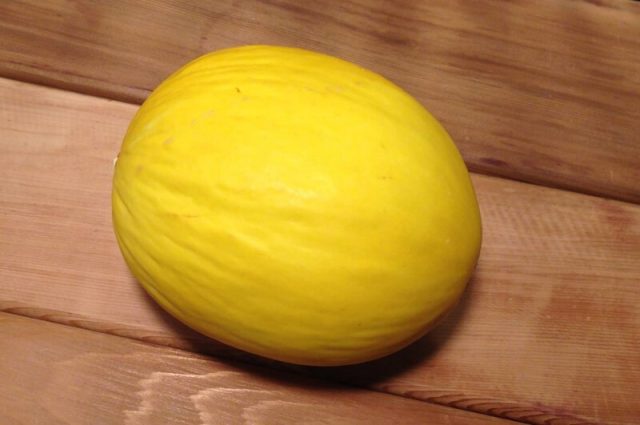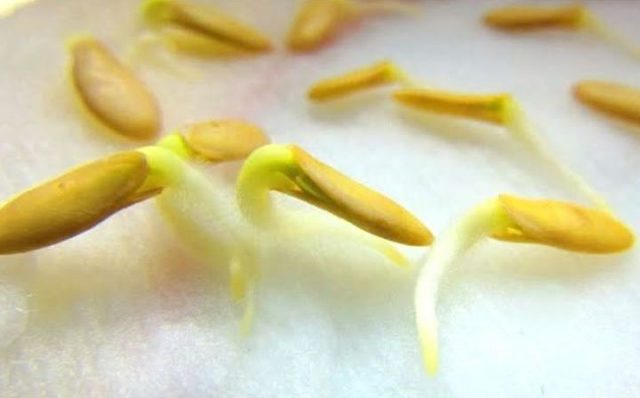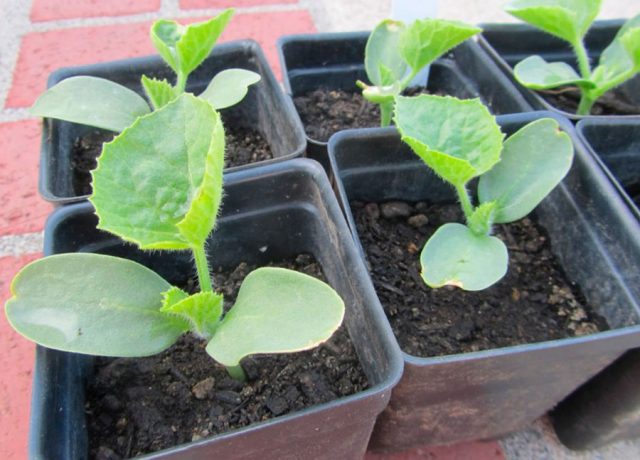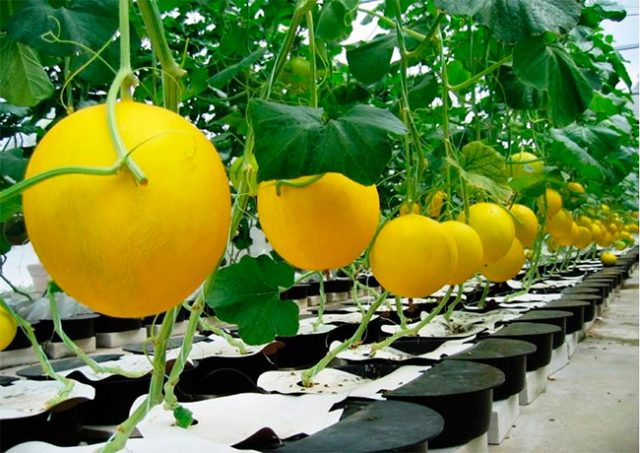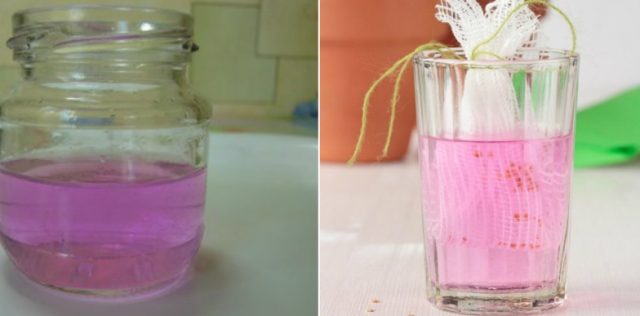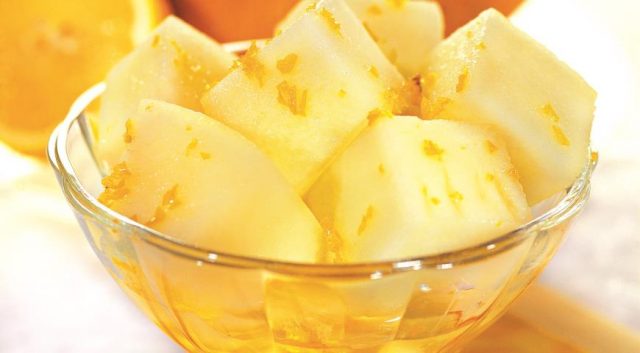Content
A universal culture, the fruits of which are used in cooking for the preparation of salads, soups, confectionery - honey melon. It is also used as an independent tasty treat. It has a special aroma, sweet taste, juicy pliable pulp. This wonderful product can be grown not only in Asian countries, but also in the southern regions of Russia.
Description of honey melon
This plant belongs to the class Pumpkin. In nature, honey melon can be found in Central and Asia Minor. Cultural varieties of Honey melon: "Kanarechnaya", "Ulan", "Skazka" are grown in the southern part of Russia, the Black Sea region, the Azov region, in the Mediterranean countries.
The fruits of this plant are round, sometimes oblong, small in size with a bright yellow smooth peel. The weight of each fruit does not exceed 2 kg. In the middle of the melon there are small oblong seeds of light yellow color.
The pulp is light beige in the center of the fruit and greenish near the peel, firm, juicy. Its aroma is bright, characteristic of these plants. The taste of the fruit is sweet, full-bodied.
Pros and cons of the variety
There were no drawbacks in the honeydew melon. Even a novice gardener can grow it. The fruits of this variety have high taste.
The advantages are:
- high productivity;
- frost resistance;
- mid-early ripening;
- undemanding care;
- sweet aromatic pulp;
- preservation of taste for several months after harvest;
- good transportability and keeping quality.
This variety is suitable for greenhouse and outdoor cultivation. Taste qualities do not depend on the cultivation method.
Growing Honey Melon
This plant is thermophilic and photophilous. Seeds begin to germinate at temperatures not lower than + 20 ° C. Basically, honey melon is rooted by seedlings in early spring in greenhouses and in early summer in the open field.
Seedling preparation
For sowing seeds, use a container not more than 10 cm in diameter. In one such cup, 2 plants can be germinated. To make crops grow faster, they are soaked in a small amount of liquid in advance, spread on gauze or cotton wool and sent to a warm place for several days. As soon as the seed cracks in the upper narrow part, it can be lowered into the ground.
The soil for honey melon seeds should be fertile and light. Before sowing, it is thoroughly crushed. Having slightly moistened the soil, sprouted seeds are lowered into it, a small layer of fluffed earth is poured on top. Seedling pots are placed in a warm, well-lit place. During the day, the air temperature should not be lower than + 20 ° С, at night + 17 ° С. A high temperature of + 27 ° C will ensure high germination.
Plants cannot be close to each other, leaves should not be in contact. As soon as 3 to 5 true leaves appear on the sprouts, they are prepared for planting in the garden plot. Before being transferred to a new place, the seedlings are hardened. They are taken to a cool room, where the air temperature during the day should be + 16 ° С, and at night it should drop to + 13 ° С.
Selection and preparation of the landing site
The honey melon is transferred to the open ground at the end of May, when the night frosts pass. A site for planting is chosen well-lit by the sun, protected from strong winds. An indent of at least 0.5 m is made between each hole.You can fertilize the soil with humus, then pour it with warm water.
Landing rules
The planting hole is made small, the seedlings of the honey melon cannot be deeply rooted. About 1 kg of humus is introduced into the prepared hole, after which 1 liter of warm water is poured. Grown plants are lowered into the resulting gruel, 2 pieces in one hole. The seedlings are turned in different directions so as not to interfere with each other's growth. After the roots are sprinkled with dry fluffed earth. If there is a likelihood of night frosts, the seedlings are covered with foil until the onset of consistently warm nights.
Watering and feeding
The first feeding of honey melon must be carried out half a month after planting. Manure, saltpeter, chicken droppings are used as fertilizers. These substances are diluted with water 1:10 and watered plants under the root. After every 2 weeks until the beginning of fruiting, the procedure is repeated.
One of the main advantages of honeydew melon is considered its drought resistance. In regions with a lack of water, this crop is not watered at all. In central Russia and in the south, agronomists advise you to water the melon at the root once every 7 days. This will make the fruit juicier.
Formation
As soon as the seedling releases the 6th leaf, it is dived so that the plant sprouts lateral shoots. Subsequently, they are also thinned out, leaving only the strongest. This promotes the flow of nutrients to the fruit and not to the leaves.
Grown plants can be directed upward along the trellis, or they can be released to curl along the ground. For vertical growth, next to the bushes, a wire is pulled about 1.5 m from the ground. Afterwards, the shoots of the honey melon are tied to it with a soft rope, directing their growth upward.
Harvesting
As soon as the fruits of the Honey Melon are poured, become uniformly yellow, acquire a sweet melon aroma, they are removed from the beds. They pluck the fruits carefully, trying not to damage or hit. They are stored intact much longer.
If a cold snap is expected, and a lot of unripe fruits remain on the site, they are plucked and sent to ripen in the room. For these purposes, special well-ventilated wooden boxes are prepared. Their bottom is lined with sawdust or straw. In the prepared container, the fruits are carefully placed so as not to damage. They are left in a dry, light place for ripening.
As soon as the fruits turn evenly yellow, they can be removed along with the container in a dark, cool place. There honey melon can be stored for about 2-3 months.
Diseases and pests
Melon Honey rarely gets sick and is almost not susceptible to pests. But the main types of diseases and harmful insects that feed on melons can attack the plant during the growth period.
Numerous fungal diseases can damage the aerial part of the plant:
- powdery mildew;
- late blight;
- peronosporosis;
- copperhead;
- root rot.
To prevent fungal infections, honey melon seeds must be treated with a weak solution of manganese before planting.
All types of pests that prefer to feed on melons can also attack the honey melon.
The main pests of culture:
- aphid;
- spider mite;
- wireworm;
- scoop;
- melon fly.
To prevent the appearance of harmful insects on the sites, it is necessary to remove plant residues, rotten leaves, cut branches of trees from the site in time. In summer, it is important to regularly plow the soil between the rows. This will partially remove the eggs and larvae of the pests.
Conclusion
Honey melon is an unpretentious melon crop that is easy to grow in any garden. It requires minimal maintenance and grows and bears fruit even in arid regions. The pulp of its fruits is used as an independent delicacy and for the preparation of delicious natural, aromatic pastry desserts.
